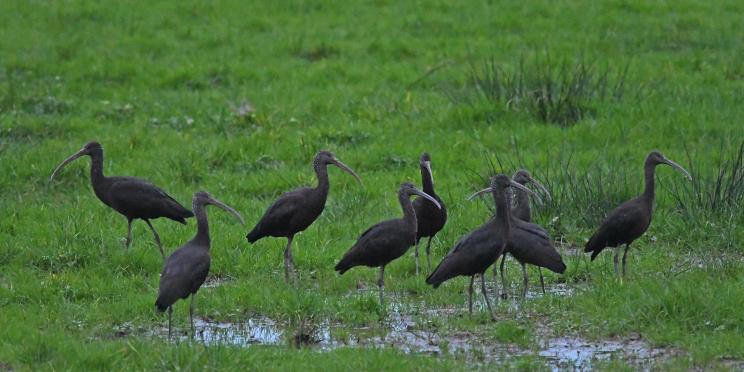Interreg-funded restoration of Lower Otter estuary attracts rare wildlife
27/01/2022

(Photo credits: Chris Townend / Wise Birding Holidays)
The Lower Otter area recently provided habitat to the largest flock of white-fronted geese seen in Devon since the 1980s just a few months after the start of its renovation supported by project Promoting Adaptation to Changing Coasts (PACCo).
In addition to the 34 white-fronted geese observed in December, nine Glossy Ibis birds were seen on the Otter estuary in January 2022. This is the biggest flock in the Otter area for more than a decade.
This new wildlife refuge was created after the excavation of a network of three kilometres of creeks at the northern end of the site which was completed in November 2021.
This constituted the first phase of the Lower Otter Restoration Project (LORP), a £15 million initiative enhancing the Otter estuary as it transforms grassland into 55 hectares of mudflat and saltmarsh, three hectares of broadleaved woodland and 1.5 kilometres of hedgerow.
The LORP is the UK arm of project PACCo, a €25.7 million Interreg France Channel England project restoring coastal wetlands in France and the UK. This will enable a better management of flooding, improve carbon absorption and provide benefits for people and wildlife.
Climate change presents a significant threat to the coastline of the Channel region, in particular estuarine and coastal areas where inappropriate use has been significant over the last 300 years.
Works supported by PACCo in the UK and France therefore aim to improve the connectivity between estuaries and their respective floodplain, enabling floodwater to drain down more quickly.
The first phase of the LORP which took place between August and November 2021 involved the relocation of a cricket pitch and the start of construction to raise South Farm Road above the floodplain, along with capping works to protect a former tip from erosion.
The project also brings significant benefits for biodiversity in these estuaries which represent a precious wildlife habitat. In the UK, it is estimated that human activity destroyed over 65% of seagrass and wetland habitat, leading to the reduction in number of 90% of important inter-tidal species. By restoring mudflat and saltmarsh, a rare landscape hosting a rich biodiversity, the reclamation work on the estuary creates new refuges for many species.
The second phase of the Lower Otter Restoration Project will start this spring, with creeks excavated in the south of the site. These will connect to the north end of the estuary under the South Farm Road bridge construction site.
In France, the PACCo-funded Basse Saâne: 2050 project entered a crucial phase in December 2021 with the start of the construction of a new water treatment plant which will improve the quality of the water released into the Saâne river, as well as the biodiversity in the area.
It is the first of three works of Basse Saâne: 2050 which aims to adapt the Saâne Valley (in Normandy) to coastal change. Between late 2022 and early 2023, a campsite in Quiberville will be moved out of the floodplain. After the closure of project PACCo, the third work will see the Saâne river reconnect to the sea in 2025 thanks to the replacement of a culvert by a frame bridge and the creation of a meander. This will, as in the Lower Otter, help accelerate the evacuation of water and restore coastal wetlands leading to increased biodiversity.
More information:
